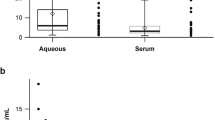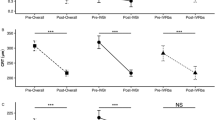Abstract
Background
To assess the relationship between baseline central corneal thickness (CCT) and/or ongoing CCT change over time with subsequent visual field progression.
Methods
One hundred sixty three eyes of 163 patients with medically treated glaucoma were followed up for 6.8 ± 1.8 years. Exclusion criteria was laser or intraocular surgery. Baseline and follow up CCT, confocal scanning laser tomography and visual fields were performed. CCT and CCT change related to visual field progression using Glaucoma Progress Analysis were assessed. Multivariate logistic regression analysis for predictive factors of glaucoma progression was used to analyze data.
Results
Thinner baseline CCT was associated with more advanced damage at presentation, mean deviation (MD) (r = 0.17, p = 0.02) and neuroretinal rim area (NRR) (r = 0.20, p = 0.02). Progressing eyes had significantly thinner (p = 0.01) baseline CCT compared to non-progressing eyes. The slope of visual field change was significantly greater (p = 0.05) for thinner (<540 μm) as compared to thicker eyes. A small but significant CCT reduction (12.78 ± 13.35 μm, p < 0.0001) was noted in all eyes; however, there was no significant difference (p = 0.95) in the amount of change between progressing and non-progressing eyes. CCT change did not correlate with MD or NRR change. A thinner CCT (Odds ratio = 1.80, p = 0.02), but not CCT change (Odds ratio = 1.07, p = 0.69), was a significant risk factor for glaucoma progression.
Conclusions
CCT correlates significantly with the amount of glaucomatous damage at presentation. Thinner corneas may be associated with increased risk of visual field progression. CCT reduced slightly over time in eyes with glaucoma; but the magnitude of this change was not related to visual field progression.



Similar content being viewed by others
References
Goldmann H, Schmidt T (1957) Uber applanationstonometrie. Ophthalmologica 134:221–242
Hansen FK, Ehlers N (1971) Elevated tonometer readings caused by a thick cornea. Acta Ophthalmol 49:775–778
Ehlers N, Bramsen T, Sperling S (1975) Applanation tonometry and central corneal thickness. Acta Ophthalmol 53:34–43
Whitacre MM, Stein RA, Hassanein K (1993) The effect of corneal thickness on applanation tonometry. Am J Ophthalmol 115:592–596
Orssengo GJ, Pye DC (1999) Determination of the true intraocular pressure and modulus of elasticity of the human cornea in vivo. Bull Math Biol 61:551–572
Doughty MJ, Zaman ML (2000) Human corneal thickness and its impact on intraocular pressure measures: a review and metaanalysis approach. Surv Ophthalmol 44:367–408
Kohlhaas M, Boehm AG, Spoerl E, Pürsten A, Grein HJ, Pillunat LE (2006) Effect of central corneal thickness, corneal curvature, and axial length on applanation tonometry. Arch Ophthalmol 124:471–476
Gordon MO, Beiser JA, Brandt JD, Heuer DK, Higginbotham EJ, Johnson CA, Keltner JL, Miller JP, Parrish RK 2nd, Wilson MR, Kass MA (2002) The Ocular Hypertension Treatment Study: baseline factors that predict the onset of primary open-angle glaucoma. Arch Ophthalmol 120:714–720
European Glaucoma Prevention Study (EGPS) Group, Miglior S, Pfeiffer N, Torri V, Zeyen T, Cunha-Vaz J, Adamsons I (2007) Predictive factors for open-angle glaucoma among patients with ocular hypertension in the European Glaucoma Prevention Study. Ophthalmology 114:3–9
Medeiros FA, Sample PA, Weinreb RN (2003) Corneal thickness measurements and visual function abnormalities in ocular hypertensive patients. Am J Ophthalmol 135:131–137
Medeiros FA, Sample PA, Weinreb RN (2003) Corneal thickness measurements and frequency doubling technology perimetry abnormalities in ocular hypertensive eyes. Ophthalmology 110:1903–1908
Leske MC, Wu SY, Hennis A, Honkanen R, Nemesure B, Barbados Eye Study Group (2008) Risk factors for incident open-angle glaucoma: The Barbados Eye Studies. Ophthalmology 115:85–93
Kim JW, Chen PP (2004) Central corneal pachymetry and visual field progression in patients with open-angle glaucoma. Ophthalmology 111:2126–2132
Herndon LW, Weizer JS, Stinnett SS (2004) Central corneal thickness as a risk factor for advanced glaucoma damage. Arch Ophthalmol 122:17–21
De Moraes CG, Juthani VJ, Liebmann JM, Teng CC, Tello C, Susanna R Jr, Ritch R (2011) Risk factors for visual field progression in treated glaucoma. Arch Ophthalmol 129(5):562–568
Hong S, Kim CY, Seong GJ, Hong YJ (2007) Central corneal thickness and visual field progression in patients with chronic primary angle-closure glaucoma with low intraocular pressure. Am J Ophthalmol 143(2):362–363
Medeiros FA, Zangwill LM, Mansouri K, Lisboa R, Tafreshi A, Weinreb RN (2012) Incorporating risk factors to improve the assessment of rates of glaucomatous progression. Invest Ophthalmol Vis Sci 53(4):2199–2207
Francis BA, Varma R, Chopra V, Lai MY, Shtir C, Azen SP, Los Angeles Latino Eye Study Group (2008) Intraocular pressure, central corneal thickness, and prevalence of open-angle glaucoma: the Los Angeles Latino Eye Study. Am J Ophthalmol 146:741–6
Brandt JD, Gordon MO, Gao F, Beiser JA, Miller JP, Kass MA, the Ocular Hypertension Treatment Study Group (2012) Adjusting intraocular pressure for central corneal thickness does not improve prediction models for primary open-angle glaucoma. Ophthalmology 119(3):437–42
Medeiros FA, Weinreb RN (2012) Is corneal thickness an independent risk factor for glaucoma? Ophthalmology 119(3):435–436
Nemesure B, Wu SY, Hennis A, Leske MC (2003) Corneal thickness and intraocular pressure in the Barbados Eye Studies. Arch Ophthalmol 121:240–4
Aghaian E, Choe JE, Lin S, Stamper RL (2004) Central corneal thickness of Caucasians, Chinese, Hispanics, Filipinos, African Americans, and Japanese in a glaucoma clinic. Ophthalmology 111:2211–2219
Foster PJ, Baasanhu J, Alsbirk PH, Munkhbayar D, Uranchimeg D, Johnson GJ (1998) Central corneal thickness and intraocular pressure in a Mongolian population. Ophthalmology 105:969–973
Weizer JS, Stinnett SS, Herndon LW (2006) Longitudinal changes in central corneal thickness and their relation to glaucoma status: an 8 year follow up study. Br J Ophthalmol 90:732–736
Brandt JD, Gordon MO, Beiser JA, Lin SC, Alexander MY, Kass MA, Ocular Hypertension Treatment Study Group (2008) Changes in central corneal thickness over time. Ophthalmology 115:1550–1556
Oriowo OM (2009) Profile of central corneal thickness in diabetics with and without dry eye in a Saudi population. Optometry 80(8):442–446
Bosworth CF, Sample PA, Johnson CA, Weinreb RN (2000) Current practice with standard automated perimetry. Semin Ophthalmol 15(4):172–181
Bengtsson B, Heijl A (2008) A visual field index for calculation of glaucoma rate of progression. Am J Ophthalmol 145(2):343–353
Leung C, Zangwill L, Girkin C (2011) Structure. In: Weinreb RN, Garway-Heath DF, Leung C, Crowston JG, Medeiros FA (eds) Progression of glaucoma. World Glaucoma Association Consensus Series 8. Kugler Publications, Amsterdam, pp 45–88
Chauhan BC, Hutchison DM, LeBlanc RP, Artes PH, Nicolela MT (2005) Central corneal thickness and progression of the visual field and optic disc in glaucoma. Br J Ophthalmol 89:1008–1012
Jonas JB, Stroux A, Velten I, Juenemann A, Martus P, Budde WM (2005) Central corneal thickness correlated with glaucoma damage and rate of progression. Invest Ophthalmol Vis Sci 46:1269–1274
Leske MC, Heijl A, Hussein M, Bengtsson B, Hyman L, Komaroff E, Early Manifest Glaucoma Trial Group (2003) Factors for glaucoma progression and the effect of treatment: the early manifest glaucoma trial. Arch Ophthalmol 121:48–56
Viswanathan D, Goldberg I, Graham SL (2012) Longitudinal effect of topical antiglaucoma medications on central corneal thickness. (2012) Sep 7. doi:10.1111/j.1442-9071.2012.02870.x
Disclosure
The authors have no financial relationship to disclose.
Author information
Authors and Affiliations
Corresponding author
Additional information
The authors have full control of all primary data and we agree to allow Graefe’s Archive for Clinical and Experimental Ophthalmology to review the data upon request.
Rights and permissions
About this article
Cite this article
Viswanathan, D., Goldberg, I. & Graham, S.L. Relationship of change in central corneal thickness to visual field progression in eyes with glaucoma. Graefes Arch Clin Exp Ophthalmol 251, 1593–1599 (2013). https://doi.org/10.1007/s00417-013-2295-6
Received:
Revised:
Accepted:
Published:
Issue Date:
DOI: https://doi.org/10.1007/s00417-013-2295-6




